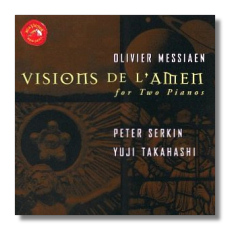
The Internet's Premier Classical Music Source
Related Links
- Messiaen Reviews
- Latest Reviews
- More Reviews
-
By Composer
-
Collections
DVD & Blu-ray
Books
Concert Reviews
Articles/Interviews
Software
Audio
Search Amazon
Recommended Links
Site News
 CD Review
CD Review
Olivier Messiaen

- Visions de l'Amen
- Catalogue d'oiseaux VII: La rousserolle effarvatte
Peter Serkin & Yuji Takahashi, pianos
RCA Victor 09026-68907-2 ADD 77:12
What a happy surprise it is to find these nearly 30-year-old recordings resurfacing on CD, even if it is a full-price reissue. Their reappearance might have something to do with the Y2K panic, and how apt Visions de l'Amen would be as a soundtrack for such an event. Or, it might simply have to do with BMG's realization (it had to come sometime) that these are excellent performances of excellent, challenging music.
Visions de l'Amen, a work for two pianos, was written by Messiaen in 1943 to perform with his erstwhile pupil (and later wife) Yvonne Loriod. It bears similarities in temperament, structure, and style to both Quatour pour la fin du temps (1941) and the Turangalîla-Symphonie (1946-48). Each of its seven movements is a different "Amen": of creation; of the stars and the "ringed planet"; of the agony of Jesus; of desire, of angels, saints, and birdsong; of the Last Judgment, and of the consummation. The composer assigns each piano a distinct function. The first (originally played by Loriod, here played by Takahashi) is given the more brilliant and rhythmically complicated role. The second (Messiaen, here Serkin) is given the harmonic foundation and the soaring principal melodies. At times, as in the final movement, Visions de la l'Amen sounds like a great celestial jangling, as if all the world's church bells were sounding at once. At other times, it is as still and rapturous as eternity. Takahashi and Serkin revel in its outrageous difficulties in a performance that is both devout and sweaty. Their tempos are generally right between the extremes set by other modern recordings of this work (Hill/Frith at the slow end and Rabinovitch/Argerich at the fast end), so perhaps this is a good consensus interpretation.
La rousserolle effarvatte (The Reed Warbler) is one of the thirteen nature-pieces that make up the Catalogue d'oiseaux, a piano cycle that occupied the composer in the late 1950s. About 30 minutes long, La rousserolle effarvatte challenges the performer and the concert hall listener alike. This is no sentimental picture-postcard, but an uncompromising look at God's creation in all its beauty, sometimes harsh splendor, and even violence. More than interpreting the bird itself, Messiaen interprets its environment: the reed banks, the sun, the other birds, the insects, the frogs and so on. The result could have been quaintly naïve, but the composer's commitment blends with his passionate musicality and taste to produce a work whose lack of concession to politesse gives it stature and integrity. It considers a span of 27 hours – from midnight to 3:00 a.m. the following day. Messiaen's poetic annotations are a helpful key. At once point, he writes, "The night is solemn, like the reverberations of a tam-tam," and elsewhere, "An unseen water-rail pierces the air with terrible cries – the shriek of hogs being slaughtered – a scream, dwindling down to silence." Such words say more about the music than mine ever could.
Serkin recorded this as the sixth side to his LP set of Messiaen's Vingt regards sur l'Enfant Jésus – this also would be a most welcome CD reissue. Half mystic and half young Turk, Serkin's temperament is exactly right for this music. He fires off long volleys of notes with as little self-consciousness (and as much technique) as the birds themselves, and he does not shy away from the more terrible aspects ("terrible" in the old-fashioned sense of terror) of Messiaen's score. It was recorded in very long takes, and the concentration shows. The piano sound is not ideal, but with music and playing like this, minor sonic shortcomings can be forgotten.
Copyright © 1999, Raymond Tuttle


















